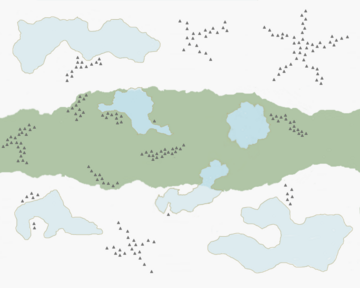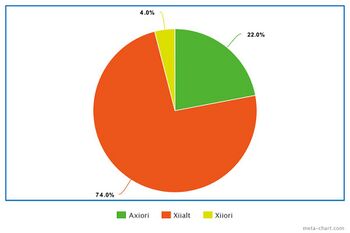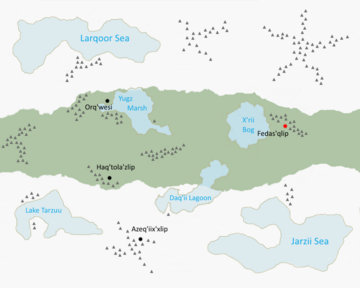Aliose
▶ This wiki page is currently behind the Phoron Scarcity update ◀
Information concerning phoron or the phoron scarcity may be outdated, lacking or unsatisfactory. Questions related to the phoron rework can be raised on Lore Discord.
| Skrell Lore Pages | ||
|---|---|---|
| Skrell | Skrell Biology · Skrell Relationships · Notable Skrell | |
| Planets, Systems, Settlements | Qerrbalak · Qerr'Malic · Aliose · Aweiji · Tattuqig · Xrim · Diulszi · Skrell Abroad · Notable Skrell Systems and Locations · Generation Fleets · The Prescient Republic of the Qar | |
| Organizations, Factions, Politics | Nralakk Federation · Skrell Politics · Skrell Enforcement · Federation Crime and Resistance · C'thur in the Federation · Dionae in the Federation | |
| Culture, Society, History | Skrell Culture · Skrell Cinema and Idols · Skrell Education · Skrell Technology · Skrell Cuisine · Skrell History · Skrell Beliefs · Skrell Mythology | |
| Aliose |
| Nralakk System |
 |
| Sector: Homeworld |
| Capital: Fedas’qlip |
| Species: Skrell, Vaurca, Dionae |
| Common Languages: Nral'Malic |
| Demonyms: Aliosen |
| Part of: Nralakk Federation |
Established in 1100 BCE, Aliose is an arctic planet with a dense, nitrogen-based atmosphere of nitrogen, necessitating specialized equipment and apparel to live on its surface. Aliose’s initial colonies were subterranean, and were primarily focused on research due to them being the first extraplanetary colonies undertaken by skrell society. While most of these colonies went on to form the population centers of the planet, some are preserved as historical relics of the colonial era.
Aliose’s beginnings as a research outpost led to its specialization in scientific research, proliferating into its many universities, such as the Aliose University of Medical Sciences. These universities and research centers today are the source of the Nralakk Federation’s scientific breakthroughs that define its reputation as the technological giant of the Spur.
| Contents |
|---|
History
Discovered by ancient astronomers in 5551 BCE, the first recorded telescopic observation of Aliose was by astronomer Vlery Ocktoq. First observations noted its starkly different composition and surface, particularly in its large icecaps. Since its discovery, skrell were captivated by the possibility of living beyond Qerrbalak and on alien worlds, with Aliose being a distant dreaming of conquering even the harshest locales in the cosmos.
By 1203 BCE, fleets of unmanned probes were sent to Aliose as part of an exploration project determining the viability of future colonies. Despite the atmosphere being nearly unbreathable and dangerously low temperatures, it was hypothetically within their ability to colonize it. Qerrbalak’s early nations celebrated the possibility of inhabiting Aliose, hopeful to see it within the near future. With decades of preparation, the initial colonization fleet departed Qerrbalak to form the first wave of colonies on it. Two months after the fleet’s launch, the first colonists landed on Aliose, consisting of the most prestigious scientific minds of Qerrbalak, most of whom were geologists and astronomers, along with medical and engineering staff. The initial month of landfall and building the foundations of the first colony were harsh, with most working extremely long shifts to see it completed.
Despite the efforts of the colonists, Aliose was an unforgiving planet. The sheer cold and violent weather patterns caused colonists to suffer severe hypothermia, and damaged colony structures from sudden temperature drops and violent winds. Most heaters and atmospheric controls suffered mechanical failures due to the strain of constant use, and eventually resulted in the death of the colony when they were unable to be repaired. The first colony’s disaster is memorialized with the Aliose Shrine, a five hundred metre-wide series of plaques engraved into a rock formation near the first landing site, commemorating the deceased.
Both Aliose and Qerr’Malic’s colonies were officially considered established in the years after 1100 BCE, with at least one permanent colony fully constructed within both colonies. Aliose’s successor colonies were equipped with specialized climate control and advanced geothermal power technology, allowing them to survive on the planet. Early terraformation efforts began during this period, with the intent to render the atmosphere breathable within the next few centuries. These advancements allowed the initial subterranean colonies to slowly expand into major population centers, with subterranean tunnel networks connecting these facilities together.
During Glorsh-Omega’s period of rule, research efforts on Aliose were managed directly by the AI, who banned research outside of its specific prioritized fields. These advancements primarily formed the immense server networks and surveillance network on the planet, allowing Glorsh-Omega to tighten its grip on the planet. Most citizens of Aliose were openly subservient to the AI, with rebels organizing a resistance group that formed the Lyukal. Aliose served as the Lyukal’s base of operations, using the planet’s complacent populace as a cover for their operatives to work underneath false identities.
Glorsh-Omega’s disappearance resulted in most of Aliose’s facilities to suddenly fail, having relied on the AI’s subroutines and surveillance network for most of their electronic equipment. The resulting collapse of infrastructure caused a period of turmoil with the surviving colonists, though this period waned as Aliose was briefly declared the interim capital of the Nralakk Federation due to being relatively intact post-collapse. Qerrbalak was made the official capital once more in 2216 CE, with Aliose being reabsorbed into the second Federation.
Environment

Aliose is primarily an icy, arctic world, with a nitrogen-majority atmosphere. Centuries of terraforming effort eventually made the atmosphere breathable to an extent, though the effort continues to this day with a controlled warming of its surface. Little native plant-life exists on Aliose’s surface beyond prokaryotic organisms, with any larger fauna considered nonexistent or extinct due to controlled climate change.
Aliose is tectonically active, with earthquakes considered a common facet of life, with modern colonies built to compensate for earthquakes and sudden land shifting. Projections on the tectonic activity rendering Aliose potentially uninhabitable due to supervolcanic eruptions, though this is considered only likely within the next twelve millenia.
Seasons
Aliose has a 553 day year, divided into 12 months, each containing 46 days. Pre-colonization, Aliose’s average surface temperature was always below freezing, with the Qu-Paalq period considered in-name only. As the colonization effort expanded, Aliose’s climate warmed due to pollution from the colonies and the terraforming project, resulting in two months of the calendar year considered the Qu-Paalq period with annual highs of 7° centigrade, with 55% humidity at its peak. The rest of the year is designated the Lu-Paalq season, with record lows of -92° centigrade. Aliose’s Lu-Paalq is defined by violent snowstorms and blizzards, with humidity in the low ranges of 35%. While skrell are adapted to handle some temperature extremes, Aliose is still considered dangerously cold, necessitating protective outdoor apparel, with the lack of humidity preventing most permanent residence outside of the arcologies without specialized humidifiers.
Economy
Orq'wesi hosts Zeng-Hu Pharmaceuticals and its associated special economic zone within the Aliose University of Medical Sciences, with a new wing dedicated to cooperative medical research and education for future chemical and pharmaceutical careers. Zeng-Hu hosts its own staffing for teaching within its wing, with the labs being commercial use for students to gain work experience as they finish their courses. This setup was designed in the hopes that students studying under Zeng-Hu’s guidance will find employment with it abroad after graduation.
Government
Aliose was the original testbed for colonial government structure formed by political theorists for future colonization efforts, with each colony considered a population center being led by a magistrate. The planet is divided into three regions, led by the current Planetary Governor Kuvaa'Purnaq Taqtoq:
- Yugz Region - Centred around the Yugz Marsh, the Yugz Region encompasses the northwestern sector of Aliose. It contains the Orq’wesi and Haq’tola’zlip colonies, and is the educational center of Aliose with a majority of universities and scientific institutions found there.
- Kirnas Region - Named after Mount Kirnas, the Kirnas Region contains Azeq’iix’xlip as its sole population center, being designated as a monitoring station for the mountain’s volcanic activity. Kirnas is considered the most rural region of Aliose, due to the lack of development here compared to the rest of the planet in spite of future settlements being slated in its future.
- Fedas Region - Named after the city and capital of Aliose, Fedas’qlip, the Fedas region contains the landing site for the original colonization of Aliose. The region has multiple heritage sites and the Aliose Shrine, commemorating the efforts of the first colonists. Multiple smaller settlements primarily exist as research outposts, dedicated to monitoring the planet’s terraforming project.
Culture and Demographics
Aliose is considered culturally insular, with most skrell forming cliques and groups based on each other’s complimentary skills, stemming from the initial colonists’ buddy system as a survival measure. This persists to the modern day, with neighbourhood groups basing themselves on each other’s skills and careers. The ongoing terraforming project has reduced the size and strength of the planet’s blizzards, though its cultural impact remains to this day. Most groups of skrell consider autonomy and self-reliance to be a desirable skill in spite of no longer being a necessity, resulting in most settlements being segmented into different cliques.
Due to Aliose’s inclement weather, the initial settlements were built using templates and in groups, ensuring that each new section has the bare essentials. Most modern settlements on Aliose contain a subterranean section from their initial construction that contains most basic utilities, with newer surface sections relegated to entertainment or non-essential facilities. Aliose’s geological activity is a constant hindrance to settlement expansion, with advances in engineering made to lessen its impact.
Despite the advancement of modern technology, the custom of self-reliance and independence from the greater whole persists. This exists in contrast with the average skrell on Aliose considered more patriotic on average, with the planet’s history including it being a main base of operations for the Lyukal, and is a point of pride for them. The Aliose flag is commonly found on equipment and buildings, with most Aliosen skrell being vocally Federation loyalists, which has earned it merit from the Federation through research grants and material support.
Holidays
- Founding Day: - Celebrated on the first day of Qu-Paalq, Aliose’s Founding Day celebrations are relatively somber. While most Founding Days remember the hardships of the past as part of their celebrations, Aliose dedicates more in remembrance of its past. Aliose’s governor hosts a televised event at the Aliose Shrine, holding a speech in commemoration of the first colonists of Aliose and their contributions to the colony’s survival, followed by a moment of silence. Little other official events are observed beyond the Aliose Shrine broadcast, with the families of the first colonies hosting private events.
- First Blizzard’s Ball: First Blizzard’s Ball is celebrated at the start of Aliose’s Lu-Paalq season, being observed by the entire planet as it marks the beginning of the new year. Official events begin with the ball, hosted within each city with skrell pairing off to dance at midnight. Traditionally, this celebration is tame before the dance, though younger skrell drink and party before, during, and after the main event.
- Lap’yal’vesi: Roughly translated to “University-Starting Celebration”, Lap’yal’vesi is a two day student celebration that marks the start of Aliose’s academic year. Freshmen celebrate this through meeting with their peers before classes start to form bonds and make friends, while the more senior students instead drink and party with remaining time left until university starts. Lap’yal’vesi is primarily celebrated in the Yugz region, with more notable celebrations in Orq’wesi, which hosts the most universities on Aliose.
Demographics and Aliens

Aliose’s few bodies of water, and a lack of accommodating features within the cities themselves, has attracted few Axiori skrell to the planet. Most skrell on Aliose are Xiialt, with Xiiori communities being much smaller than those on Aweiji and Qerrbalak.
Outside of Qamlok, very few Vaurca live on Aliose, with the majority of C'thur outside of it being Zeng-Hu employees. Zeng-Hu’s operations within the planet’s special economic zone resulted in a small number of humans residing on Aliose, being primarily employees or students. Small diona communities exist on Aliose as well, with the majority of them being students due to the planet’s lack of warmth and sunlight, rendering it unappealing for permanent residence.
Skrell
Skrell make up roughly 96% of Aliose’s population. The percentages below are of the skrell population only.
- 22% Axiori
- 74% Xiialt
- 4% Xiiori
Non-Skrell
Non-skrell make up roughly 4% of Aliose’s population. The percentages below are of the Non-skrell population only.
- 97% Diona
- ~<1% Human
- ~2% Vaurca
Veterans Lodge
The Veterans Lodge is an organisation founded by Lyukal veterans, intending to teach younger generations of skrell of the Glorsh-Omega period.
Most members of the Veterans Lodge regularly hold positions as guest speakers or lecturers across the universities on Aliose, giving speeches regarding their experiences under Glorsh-Omega, or their contributions to the Lyukal movement. Their presence within education, combined with their emotional speeches, have turned many veterans into minor Idols, a position they then use to promote the Federation and its ideals in the younger populace.
Despite their outward Federation loyalty, most members of the Veterans Lodge secretly follow a unique interpretation of Suur’ka. Suur’ka originated in the turbulent aftermath of Glorsh-Omega’s disappearance, with Haq’tola’zlip collapsing overnight as the infrastructure and connections to the rest of the Federation failed without the AI’s presence. Thousands of skrell died during the chaos, before the Lyukal in the city reestablished order through what would become the basis of Suur’ka’s ideology. With the reformation of the Nralakk Federation, and Suur’ka becoming a prohibited ideology by it, the open practice of their philosophy fell into secrecy amongst Lyukal members.
Suur’ka would continue to evolve over time, being directly influenced by vocal followers such as Lorash Qui’xo, who created the basis of modern Suur’ka. Despite its outside influences, most teachings that Veterans Lodge members adhere to is unique to them. The Suur’ka belief followed on Aliose revolves around Hoqom'Es-Masyara, or the ‘Law of Ice Society’:
Hoqom'Es-Masyara
- You are not to think you are superior to us unless you can prove it.
- You are not to think you are more important than us unless you can prove it.
- You are not to think you are allowed to transgress against us unless you can prove it.
Despite having fallen into obscurity, the Ice Society Law was enforced by the Lyukal of Haq’tola’zlip. Being made to address any conflict within the city, the simple set of rules were a direct challenge to skrell to prove their actions as correct, or else be found guilty and punished for willingly committing an incorrect action. With the majority of the city’s infrastructure destroyed during this period, the Lyukal were forced to adopt this harsh rule of law. Theft from those hoarding important supplies was justifiable in the Lyukal's eyes, and was supported through their new form of law.
Today, the Veterans Lodge maintains their unique interpretation of Suur’ka. Members of the Lodge consider the Nralakk Federation at risk of collapsing a second time, and hold that free will and the independence are important tenets to ensure that the conditions that allowed Glorsh-Omega to exist will never be repeated.
The remaining members of the Veterans Lodge are all aware of their advanced age, having spent their youth in the reign of Glorsh-Omega. Recruitment of younger skrell is difficult due to the members of the Lodge attaining minor Idol status through espousing Federation ideals, all while secretly practicing an outlawed ideology that would alienate most prospective members. Few skrell spurred by the nationalist ideals of upholding the Nralakk Federation’s beliefs are willing to turn a blind eye to their practice, with what recruits that can bring in being carefully chosen to avoid being exposed.
Major Cities and Landmarks

Fedas’qlip
Fedas’qlip is the capital of Aliose, as well as the first colony. The city is roughly sixteen kilometers in diameter, with its subterranean section reaching twenty kilometers underground. The city maintains the largest electronic display of dissertations in the Federation, with a museum dedicated to displaying the academic work of the students from all of Aliose’s universities. These displays are directly linked to the Orq’wesi Archive, where the original documents are preserved.
Fedas’qlip also acts as the headquarters for Aliose’s terraforming project, which intends to make the surface temperature of Aliose habitable for skrell. Aside from the heritage sites that mark the initial colonization of Aliose, multiple field labs dedicated to the project and monitoring its progress are found all across the region.
Azeq’iix’xlip
Azeq’iix’xlip was originally a monitoring station for the largest active volcano on Aliose, Mount Kirnas. While still tasked with monitoring and processing volcanic and seismic data, Azeq’iix’xlip has slowly developed into a proper city. The original residents of the city hold backgrounds in geology, with most scientific idols in the field hailing from there.
Since its founding, Azeq’iix’xlip has witnessed over a thousand eruptions. While the volcano shows no signs of endangering the city in the near future, emergency protocols are still practiced in the event of a catastrophic eruption. The city has few surface structures, being entirely underground save for a few buildings and its entrance, being reinforced to account for the geological activity in the area.
Orq’wesi and Qamlok
Orq’wesi is the educational center of Aliose, hosting multiple prestigious universities, with the most notable being the Aliose University of Medical Sciences. Out of Orq’wesi’s total population, roughly one fifth is made up of attending students.
The city has a bustling nightlife and hospitality sector catering to the student body, with large sections of Orq’wesi dedicated to student accommodation, clubs, bars, and restaurants. Orq’wesi is well-known for its various work experience programs, making it a common sight to see businesses staffed by students. One of Aliose’s holidays, Lap’yal’vesi, is a two-day celebration that kicks off the new academic year, with the majority of celebrations taking place within itself.
Other than its involvement in academia, Orq’wesi also hosts the Orq’wesi Archive, which is dedicated to the archival of the species’ medical knowledge through the Aliose University of Medical Sciences, and recording of skrell history from the Glorsh-Omega period onwards. Students attending AUMS are expected to spend at least one semester working within the archive, helping gather information before being submitted, with students graduating with high marks taking part in a ceremony where they personally archive their dissertation.
Qamlok
Qamlok is a subterranean settlement near the outskirts of Orq’wesi, inhabited almost entirely by C’thur researchers in the pursuit of scientific advancement for the betterment of the C'thur Hive and their allies.
The location was originally planned to house vaurca aiding in the research of the nearby Aliose University of Medical Sciences, but the rapidly growing C’thur scientific community under [[|Mouv,_The_Recondite_Queen|Ta'Akaix'Mouv'lek'tanta]] saw it beneficial to conduct research independent of the university. This led to the construction of a laboratory where C'thur spearheaded their own research, though most research still occurs on the university’s campus.
Recently, new bound vaurca from Mouv’s brood have been tasked alongside a team of skrell research officials into translating many of C’thur’s databases into Nral'malic, with a particular focus on vaurcaesian biomedical research for archival within the Orq'wesi Archive. This task has been laborious for all parties involved due to vaurcae reliance on direct peer-to-peer communication for information storage. The use of Bound for the project has also been a point of contention, but has been sanctioned by the Federation.
Haq’tola’zlip
Haq’tola’zlip shares the distinction of being the oldest settlements on Aliose with its sister-city Fedas’qlip. After Glorsh-Omega’s disappearance, the city fell into turmoil with its population descending into chaos after the collapse of its infrastructure. Most of the original settlement was destroyed, only rebuilt after the second Nralakk Federation formed, with only a third of the original population surviving the event.
During Glorsh-Omega’s rule, Haq’tola’zlip was the main base of operations of the Lyukal, with the majority of their operations hosted within it. Multiple universities focusing on humanities and history have since formed in light of the city’s storied past, with many of them employing veteran Lyukal members as guest speakers and lecturers due to their status as being idolized as heroes of the Federation.
Surviving members of the Lyukal have formed the Veteran’s Lodge within Haq’tola’zlip, whose goal is to ensure that the newer generations of skrell learn of Glorsh-Omega’s reign, and to reinforce pro-Federation ideals.
Mount Kirnas
Mount Kirnas is the largest mountain on Aliose, located in its southern mountain ranges. An immense landmark looming over the city of Azeq’iix’xlip, the mountain is also the most active volcano on the planet, being the reason for the city’s establishment.
The inhabitants of Aliose hold reverence for the Mount Kirnas, with some skrell performing personal rituals before beginning their journey to one of Mount Kirnas's many field labs, hoping to ward off any violent eruptions during their work. These rituals can range from simple good-luck drinks shared between coworkers before setting off, to following designated “lucky” routes while travelling closer to the mountain.
| Skrell Lore Pages | ||
|---|---|---|
| Skrell | Skrell Biology · Skrell Relationships · Notable Skrell | |
| Planets, Systems, Settlements | Qerrbalak · Qerr'Malic · Aliose · Aweiji · Tattuqig · Xrim · Diulszi · Skrell Abroad · Notable Skrell Systems and Locations · Generation Fleets · The Prescient Republic of the Qar | |
| Organizations, Factions, Politics | Nralakk Federation · Skrell Politics · Skrell Enforcement · Federation Crime and Resistance · C'thur in the Federation · Dionae in the Federation | |
| Culture, Society, History | Skrell Culture · Skrell Cinema and Idols · Skrell Education · Skrell Technology · Skrell Cuisine · Skrell History · Skrell Beliefs · Skrell Mythology | |







